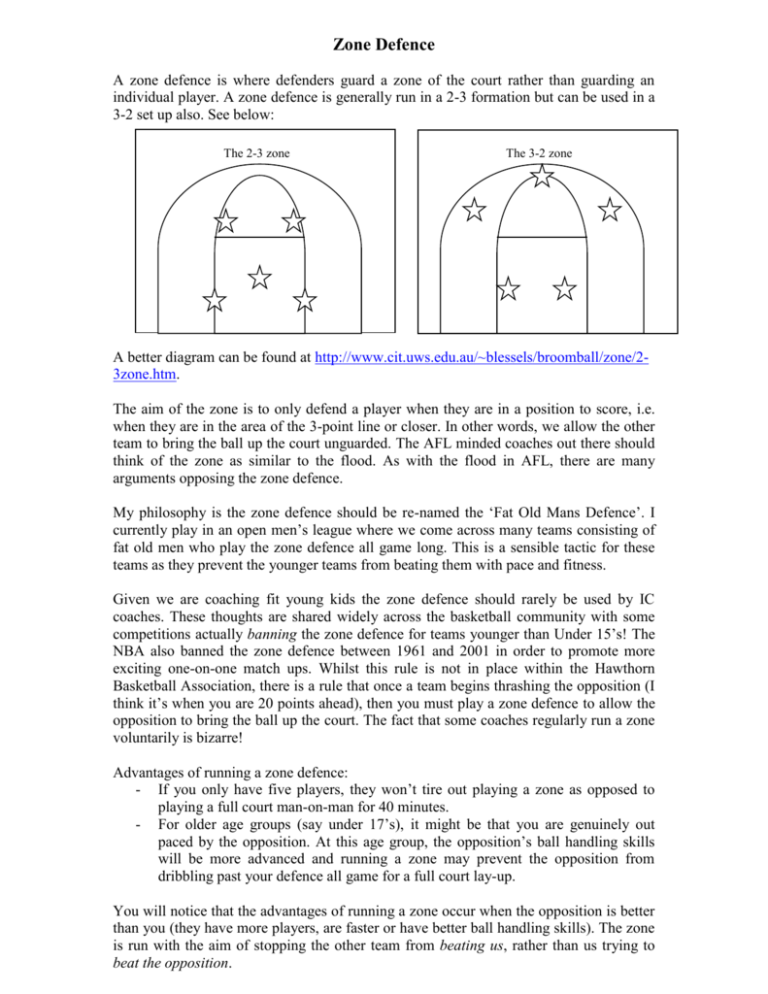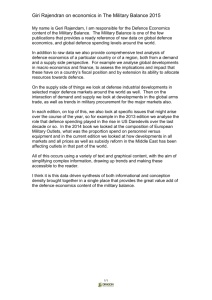Zone Defence - IC Basketball
advertisement

Zone Defence A zone defence is where defenders guard a zone of the court rather than guarding an individual player. A zone defence is generally run in a 2-3 formation but can be used in a 3-2 set up also. See below: The 2-3 zone The 3-2 zone A better diagram can be found at http://www.cit.uws.edu.au/~blessels/broomball/zone/23zone.htm. The aim of the zone is to only defend a player when they are in a position to score, i.e. when they are in the area of the 3-point line or closer. In other words, we allow the other team to bring the ball up the court unguarded. The AFL minded coaches out there should think of the zone as similar to the flood. As with the flood in AFL, there are many arguments opposing the zone defence. My philosophy is the zone defence should be re-named the ‘Fat Old Mans Defence’. I currently play in an open men’s league where we come across many teams consisting of fat old men who play the zone defence all game long. This is a sensible tactic for these teams as they prevent the younger teams from beating them with pace and fitness. Given we are coaching fit young kids the zone defence should rarely be used by IC coaches. These thoughts are shared widely across the basketball community with some competitions actually banning the zone defence for teams younger than Under 15’s! The NBA also banned the zone defence between 1961 and 2001 in order to promote more exciting one-on-one match ups. Whilst this rule is not in place within the Hawthorn Basketball Association, there is a rule that once a team begins thrashing the opposition (I think it’s when you are 20 points ahead), then you must play a zone defence to allow the opposition to bring the ball up the court. The fact that some coaches regularly run a zone voluntarily is bizarre! Advantages of running a zone defence: - If you only have five players, they won’t tire out playing a zone as opposed to playing a full court man-on-man for 40 minutes. - For older age groups (say under 17’s), it might be that you are genuinely out paced by the opposition. At this age group, the opposition’s ball handling skills will be more advanced and running a zone may prevent the opposition from dribbling past your defence all game for a full court lay-up. You will notice that the advantages of running a zone occur when the opposition is better than you (they have more players, are faster or have better ball handling skills). The zone is run with the aim of stopping the other team from beating us, rather than us trying to beat the opposition. Reasons not to run a zone defence: - The zone allows the opposition to bring the ball up the court un-guarded. Players in younger age groups do not have ball handling skills that are developed in such a way that allows them to bring the ball up the court against a man-to-man defence easily. Allowing players to bring the ball up the court unguarded is like allowing a golfer to tee-off from the green! Make players earn every meter of distance, as every dribble the other team takes is a chance for us to turn the ball over. - If you have more than seven players, then use them! Don’t stick them down the other end of the court in a zone, make them run and tire them out so when they get on the bench they actually need a break. - Playing the Fat Old Man’s Defence teaches players to play basketball like fat old men. Playing man-to-man defence teaches players good defence. This is the main argument opposing the zone defence as players never learn proper defence unless they play one-on-one accountable basketball. Having considered all these points, I hope you are more equipped to decide on the defence your team should play. In my opinion, the only way players learn the game properly is by playing a full court defence.








